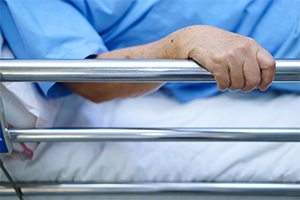
As we age, our bones and joints start to break down, a natural part of the aging process. We become weaker than we were before and more easily fatigued due to the stress that our bodies have been under for decades. However, some aging populations develop osteoporosis—a bone disease that occurs when the body loses too much bone, resulting in weak bones that may become brittle and break from minor bumps and falls.
What is osteoporosis?
Osteoporosis means “porous bone,” and if viewing osteoporosis bones under a microscope, they make look a lot like the honeycombs of bee hives. Small holes and spaces appear in the bone mass and are much larger than the holes and spaces that appear in healthy bones. While we think of bone as a static part of our body that never changes, bone is actually living tissue and can regenerate itself if broken (think of how a broken arm bone heals over time.) Osteoporosis is when the creation of new bone doesn’t keep up with the loss of old bone mass.
Osteoporosis causes bones to become brittle and frail, meaning that they are prone to breaking even over slight accidents, like bending over or coughing heavily. Osteoporosis-related injuries most commonly occur in the hip, wrist and spine.
What causes osteoporosis?
Because bones are living tissue, they constantly refresh their cells—just like our skin and hair. When new bone is made, old bone is broken down and disappears. In children and young adults, this process is very fast, but after most of us turn 30, our bone mass has stagnated and new bone growth is slower. As people age, the bone refresh process slows down even further. Generally speaking, you will have the most bone mass you will ever have by the time you are 30 years old.
While there is no one thing that directly causes osteoporosis besides the natural aging process, there are some medical conditions and medications that can cause premature bone loss, which puts you at risk for osteoporosis. Long-term use of steroid medication like cortisone or prednisone can cause bone loss, as well as SSRIs, thyroid hormone replacement, lithium, blood thinners, cancer drugs, infertility drugs, anti-seizure drugs, and even some antacids.
What are the risk factors for osteoporosis?
A number of factors increase the risk of osteoporosis, many of which cannot be changed. The risk factors for osteoporosis are:
• Sex and age. Women are much more likely to develop osteoporosis than men, and older women in particular are especially at risk.
• Race plays a part in osteoporosis risk. Those of white and Asian descent are most at risk of osteoporosis
• Having a family history of osteoporosis increases your risk of osteoporosis. Having a parent or sibling is a special risk.
• Body frame size plays a part in your osteoporosis risk. Those with small body frames typically have a higher risk because they have less bone mass to work with once they reach the age of 30.
• Osteoporosis is more likely to occur in people who have low calcium intake, eating disorders, or gastrointestinal surgeries
• Osteoporosis is more likely to occur in people who have hormone imbalances, thyroid problems or adrenal gland issues, celiac disease, IBS, kidney disease, lupus, cancer or rheumatoid arthritis.
• People with a sedentary lifestyle are at a higher risk for osteoporosis because weight-bearing exercise strengthens the bones or your body and promotes bone balance.
• Heavy drinkers have an increased risk of osteoporosis because of the dehydrating effect of alcohol on your body.
How do I know if I have osteoporosis?
Osteoporosis usually doesn’t have many signs or symptoms, and usually the first line of defense is to prevent osteoporosis altogether. Some symptoms of late-stage osteoporosis include:
• Back pain
• Loss of height over time
• Stooped posture
• Bones that break much easier than expected
Many people with osteoporosis do not know they have it until they break a bone—and that’s why regular screenings are so important. Screening for osteoporosis is recommended for women who are over the age of 65 or women who are over the age of 50 and have any of the above risk factors. Screening is typically done using low-level X-Ray technically to show the level of bone mass.
Bone density tests like these can be done on any bone in the body and are virtually painless. Bone density tests are the only tests that can diagnose osteoporosis before a broken bone occurs. Women over the age of 50 or 65 should have this test repeated annually.
How is osteoporosis diagnosed and treated?
There is no one right way to treat osteoporosis and your physician should work closely with you to find the right protocol for your body. Some medications are more appropriate for certain people and may depend on the severity of the osteoporosis and your risk factors.
Aside from medication, treating and living with osteoporosis can be as easy as making some lifestyle changes. Getting enough Vitamin D and calcium is essential, as well as avoiding medications that can make bones weaker. Limiting alcohol and avoiding smoking are always good habits, as well as exercising regularly to keep bones strong and healthy. Good nutrition and regular exercise are essential for keeping your bones—and your body—healthy throughout your life.
Disclaimer: The contents of this article, including text and images, are for informational purposes only and do not constitute a medical service. Always seek the advice of a physician or other qualified health professional for medical advice, diagnosis, and treatment.








